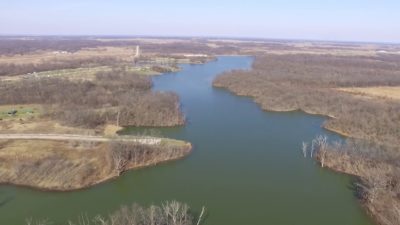The Illinois Department of Natural Resources is using some extra funds from a natural partnership to help with farmland conservation, improve water quality, and increase waterfowl habitat in West Central Illinois. IDNR has received a total of more than $8 million from the USDA Natural Resources Conservation Service through its Regional Partnership Program. The partnership is being used by DNR-contracted tenant farmers near the Jim Edgar Panther Creek State Fish & Wildlife Area in Cass County to help with waterfowl population and for a new program involving cover crops.
IDNR’s Bob Caveny says they are attempting to incentivize their tenants with cover crops to promote water and land conservation and promote water and land fowl habitat. “We are looking to do 3 things. First, invest in our soil and improve our soil health. We want to work with our tenants and train them how to use cover crops, because most of our tenants also farm the grounds adjacent to our state lands. If they have a learning ground on how to do it properly, we are going to help cover the risk and everything and the costs of doing it. They can learn to do it, and hopefully, they’ll take it back to to their own farms right next door. Third, we want to use them as demonstration sites around the state for ag groups. We are planning on having two in each region across the state to make sure there is an ample opportunity for groups and people to watch this process, and so they don’t have to travel too far to do it.”
Caveny says they currently have 240 tenant farmers employed at IDNR. Of those 240, Caveny says that IDNR is going to focus the program on grassland bird sites like Panther Creek and Pyramid State Park in Perry County. He says its eventually going to open up to all leases across the state. Caveny says IDNR will cover half of the seed and planting costs after the farmer registers with the local NRCS office, and then, DNR will also make a payment to the farmer directly from the NRCS program for their work. “Our plan is, once we get going on these contracts is to basically subsidize the farmer for 3-5 years, depending upon when the contract expires and when they’re starting in the program. After that 4 year period, we plan on requiring another lease agreement. Basically, we’re looking at covering the costs the first 3-5 years to get the farmer established and make it profitable. Most of the cover crop research shows that after 3-5 years utilizing cover crop rotation, it can be profitable for a farmer due to reduced input costs.”
Caveny says the University of Illinois will be doing research during the planting process on the grassland bird population. Caveny says his own research in the project will be on soil sampling and health. He says he’s standardized a soil sampling grid for all the locations to check quality as the project moves forward and to take the responsibility away from the farmer. He says it will also provide standardized numbers and timely samples, giving a clearer picture on if the process is working properly.
Illinois was one of 29 states that received the reward from the federal government. Caveny says about $1.7 million of the award will come directly to central and southern Illinois’ grounds during the duration of the project.




